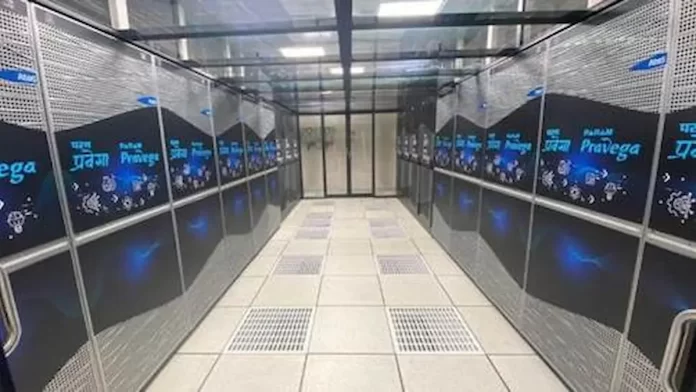National Super Computing Mission is making India evolve as a frontrunner in high power computing. As part of the mission, India has already installed Supercomputing infrastructure in 10 premier institutions like IITs, IISc, IISER Pune, JNCASR Bengaluru, various C-DACs, NABI Mohali.
The final stage installation work is being carried out in 5 more institutions and when completed will they benefit researchers from several other institutions too.
This will not only help meet the increased computational demands of academia, researchers, MSMEs, and startups in areas like oil exploration, flood prediction as well as genomics, and drug discovery, but also firm up the indigenous capability of developing supercomputers.
What is National Supercomputing Mission?
The National Supercomputing Mission was launched to enhance the research capacities and capabilities in the country by connecting them to form a supercomputing grid, with National Knowledge Network (NKN) as the backbone.
Under this mission, a grid of supercomputing facilities is being set up in academic and research institutions across the country.
This mission seeks to provide access to High-Performance Computing (HPC) Facilities to 100 several institutions and more than thousands of active researchers, academicians working through Nation Knowledge Network (NKN) – the backbone for supercomputing systems.
Part of this is being imported from abroad, and partly built indigenously, the latter being increased with time.
The National Supercomputing Mission is being jointly steered by the Department of Science and Technology (DST) and the Ministry of Electronics and Information Technology (MeitY) and implemented by the Centre for Development of Advanced Computing (C-DAC), Pune, and the Indian Institute of Science (IISc), Bengaluru.
Focus on Indigenous Technology
Design and development of indigenous server nodes, interconnect switch, storage, and system software stack for next generation of High-Performance Computing (HPC) systems has been initiated with 85% indigenous manufacturing.
This includes India’s first indigenous server platform called ‘Rudra’, which can meet the HPC requirements of all governments and PSUs as well as the strategic needs of the country.
Besides, a next-generation indigenous HPC interconnect called “Trinetra” has been designed and developed in the country for efficient inter-node communication between compute nodes. This will help improve power efficiency and also support large-scale systems.
India’s top Supercomputers
As part of the National Supercomputing Mission (NSM), the Indian Institute of Science (IISc) Bengaluru has installed Param Pravega, one of the most powerful Indian supercomputers.
Param Pravega having a supercomputing power of 3.3 petaflops, is the largest supercomputer that has been installed in an Indian academic institution.
PARAM Shivay, the first supercomputer assembled indigenously, was installed in IIT (BHU), followed by PARAM Shakti, PARAM Brahma, PARAM Yukti, PARAM Sanganak at IIT-Kharagpur IISER, Pune, JNCASR, Bengaluru and IIT Kanpur, IIT Hyderabad, NABI Mohali, CDAC Bengaluru respectively.
In the upcoming year, 9 more supercomputers will be commissioned and installed in institutes like IIT Bombay, IIT Madras, IIT Patna, IIT Delhi, IUAC Delhi, CDAC-Pune, SNBNCBS, NCRA Pune, and NIC Delhi.
Supercomputing and Artificial Intelligence
India’s march towards leadership position in supercomputing found a fresh dimension with the convergence of HPC and Artificial Intelligence (AI).
A 200 AI PF Artificial Intelligence supercomputing system created and installed in C-DAC can handle incredibly large-scale AI workloads, increasing the speed of computing-related to AI several times.
PARAM Siddhi – AI, the high-performance computing-artificial intelligence (HPC-AI) supercomputer, has achieved a global ranking of 62 in the TOP 500 most powerful supercomputer systems in the world, released on 16th November 2020.
The National supercomputing mission has also created the next generation of supercomputer experts by training more than 11,000 HPC-aware manpower and faculties.
To expand the activities of the HPC training, four NSM Nodal Centres for training in HPC and AI have been established at IIT Kharagpur, IIT Madras, IIT Goa, and IIT Palakkad.
These centers have also conducted online training programs in HPC, AI, and other areas.
Powered by the National supercomputing mission, India’s network of research institutions, in collaboration with the industry, is scaling up the technology and manufacturing capability to make more and more parts in India, taking indigenous manufacturing to 85%.
